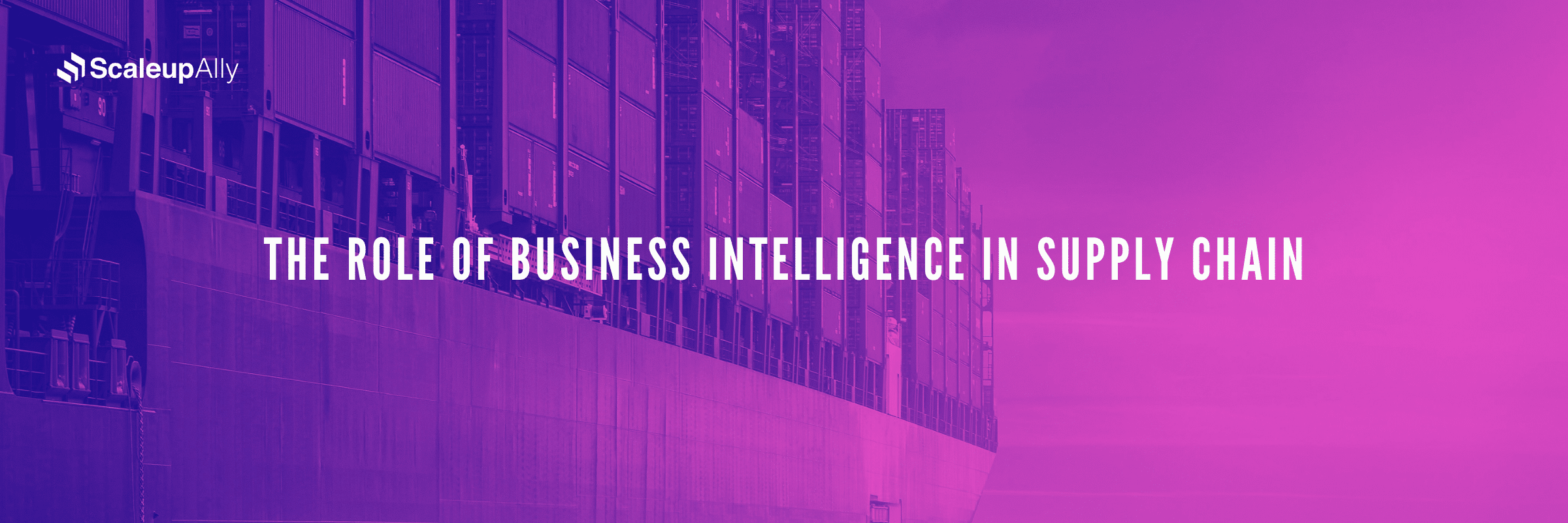
The Role of Business Intelligence in Supply Chain
Tarsem Singh | March 6, 2025 , 18 min read
Table Of Content
6 in 10 companies plan to invest in digital technology to bolster their supply chain processes, data synthesis and analysis capabilities. Business intelligence refers to the collection, analysis, and interpretation of data to provide actionable insights for decision-making. In the context of supply chain management, BI involves the use of advanced analytics tools and technologies to gather and process data from various sources within the value chain.
The goal is to identify patterns, trends, and anomalies in the data to optimise supply chain operations, improve responsiveness, and enhance overall performance.
Supply chain management is a complex and dynamic process that involves multiple interconnected parties, operations, and resources.
In today’s volatile and competitive business environment, it is crucial for organisations to have a comprehensive understanding of their supply chain operations and make informed decisions to optimise efficiency and mitigate risks.
Supply chain experts currently encounter a multitude of obstacles. While some of these hurdles are easily noticeable, others remain concealed. Nevertheless, it is imperative for supply chain specialists to proactively address both types in order to prevent expensive disruptions.
This is where business intelligence (BI) plays a vital role. In this article, we will explore the various aspects of business intelligence in supply chain management and its benefits for organisations.
Key Takeaways
- Business intelligence transforms raw data into actionable insights for improved supply chain decision-making.
- BI tools optimize supply chain efficiency by analyzing patterns, trends, and anomalies in data.
- Real-time monitoring with BI enables prompt issue resolution, mitigating risks and avoiding costly disruptions.
- Predictive analytics in BI supports demand forecasting, inventory optimization, and proactive resource allocation.
- Collaboration through BI fosters transparency and alignment among supply chain stakeholders.
- BI enhances customer satisfaction by streamlining operations and ensuring timely delivery of products.
What is supply chain business intelligence?
- What is supply chain business intelligence?
- What role does business intelligence play in supply chain management?
- Benefits of Business Intelligence in Supply Chain Management
- How can you get started with Supply Chain Business Intelligence?
- Cost of Implementing Business Intelligence in Supply Chain
- Challenges and Considerations in Implementing Business Intelligence in Supply Chain Management
- How do enterprises apply business intelligence to supply chains?
- Real-life Examples of BI in Supply Chain
- Best BI Tools For Supply Chain Management
- How can ScaleupAlly Help?
- Wrapping Up: Using Business Intelligence for Supply Chain
- Frequently Asked Questions
- Further Reading: Business Intelligence Applications Across Sectors
Supply chain business intelligence (BI) refers to the use of data analysis tools and techniques to gain insights into the various processes and activities within a supply chain.
This involves collecting, integrating, analyzing, and presenting data from different parts of the supply chain to help organizations make informed decisions. The primary goal of supply chain BI is to improve operational efficiency, enhance decision-making, and drive strategic planning.
What role does business intelligence play in supply chain management?
Business Intelligence (BI) plays a pivotal role in modern supply chain management, offering a robust set of functionalities that empower organisations to harness data for informed decision-making. These functionalities, essential for thriving in today’s dynamic business landscape, encompass a range of critical factors:
- Data Collection and Integration: BI tools gather data from multiple sources such as inventory systems, transportation management systems, and customer relationship management systems. This data is then integrated and transformed into a unified format for analysis.
- Data Analysis and Visualization: BI tools utilise advanced analytics techniques to analyze the integrated data and generate meaningful visualisations, such as dashboards and scorecards. These visualisations provide a comprehensive view of key performance indicators (KPIs) and help stakeholders identify trends and patterns.
- Real-time Monitoring and Alerts: BI tools enable real-time monitoring of supply chain operations by continuously collecting and analysing data. This allows organisations to identify and address issues promptly, such as inventory shortages or delivery delays. Alerts can be set up to notify stakeholders of critical events or deviations from predefined benchmarks.
- Predictive Analytics: BI tools leverage predictive analytics models to forecast future demand, optimise inventory levels, and anticipate supply chain disruptions. By analysing historical data and external factors, organisations can make proactive decisions to mitigate risks and optimise resource allocation.
- Collaboration and Communication: BI tools facilitate collaboration and communication among supply chain stakeholders by providing a centralised platform for data sharing, reporting, and decision-making. This improves visibility and transparency across the supply chain, enabling better coordination and faster response to changing market conditions.
Now that we’ve explored the pivotal role of business intelligence in supply chain management, let’s delve deeper into the tangible benefits that organisations can derive from harnessing the power of BI in their supply chain operations. Understanding the significance of BI in optimising supply chains will pave the way for a closer examination of how it translates into real-world advantages and efficiencies.
Benefits of Business Intelligence in Supply Chain Management
There are several benefits of using BI in supply chain management, including improved visibility and transparency, reduced costs, increased efficiency, improved decision-making, and increased customer satisfaction. Let’s discuss each on these in detail:
- Improved visibility and transparency: With BI tools, organisations can track their supply chain activities in real-time and gain a holistic view of their operations. This allows them to identify any bottlenecks or inefficiencies in the supply chain and take corrective actions promptly. By having a clear and transparent view of the entire supply chain, companies can proactively address issues and improve overall performance.
- Reduced costs: Using business intelligence for supply chain also enables organisations to identify cost-saving opportunities by analysing data from various sources such as inventory levels, transportation costs, and supplier performance. By identifying areas where costs can be optimised, companies can implement strategies to reduce expenses and improve profitability. For example, by using BI to analyze transportation data, companies can identify the most cost-effective routes and modes of transportation, resulting in significant cost savings.
- Increased efficiency: BI also helps in increasing efficiency in supply chain management. By analysing data related to production schedules, inventory levels, and demand patterns, organisations can identify areas where processes can be streamlined and made more efficient. For example, BI tools can provide insights into production bottlenecks or excess inventory levels, enabling companies to optimise their production schedules and reduce lead times. This leads to improved operational efficiency and better resource utilisation.
- Improved decision-making: With access to real-time data and advanced analytics capabilities, organisations can make informed decisions based on accurate and up-to-date information. BI tools provide actionable insights that enable managers to make data-driven decisions related to procurement, inventory management, production planning, and distribution. This leads to more effective decision-making and better outcomes for the organisation.
- Increased customer satisfaction: BI in supply chain management can result in increased customer satisfaction. By analysing customer data, organisations can gain insights into customer preferences, buying patterns, and satisfaction levels. This information can be used to tailor products and services to meet customer expectations better. Additionally, by optimising supply chain operations through BI, organisations can ensure timely delivery of products and reduce stock outs or backorders, resulting in improved customer satisfaction.
How can you get started with Supply Chain Business Intelligence?
Effective utilisation of Business Intelligence (BI) is pivotal in enhancing and streamlining an organisation’s supply chain.
Through the strategic utilisation of data and analytics, companies can unlock actionable insights, pinpoint optimization opportunities within their supply chain operations, and empower data-driven decision-making to boost overall efficiency.
If you are looking to get started with BI for your supply chain, here are some steps you can take to embark on this journey.
STEP 1: Understanding the Role of BI in Supply Chain
The first step in implementing BI for your supply chain is to understand the role it plays and the benefits it can bring to your organization. Business Intelligence allows you to collect, analyze, and visualize data from various sources within your supply chain, such as inventory levels, production rates, transportation costs, and customer demand.
By having access to this data in real-time, you can identify patterns, trends, and potential bottlenecks in your supply chain, enabling you to make proactive decisions and optimise your operations.
STEP 2: Assessing Data Management Capabilities
Next, it is essential to assess your current data management capabilities and infrastructure. To leverage BI effectively, you need to have a robust data management system in place. This includes ensuring that your data is accurate, up-to-date, and stored in a centralised location that is easily accessible by all relevant stakeholders.
If you find any gaps or deficiencies in your data management processes, it may be necessary to invest in tools or systems that can streamline data collection, storage, and integration.
STEP 3: Defining Relevant Key Performance Indicators (KPIs)
Once you have established a solid foundation for data management, the next step is to determine the key performance indicators (KPIs) that are most relevant to your supply chain.
These KPIs will help you measure the success of your BI initiatives and track progress towards your goals. Some common KPIs in the supply chain include on-time delivery performance, inventory turnover ratio, order fulfillment rate, and transportation cost per unit. By defining these metrics, you can monitor your performance and identify areas that require improvement.
STEP 4: Selecting the Right BI Tools and Technologies
After identifying the relevant KPIs, the next step is to select the right BI tools and technologies that align with your organization’s needs and goals. There are numerous BI platforms available in the market that offer features such as data visualization, predictive analytics, and interactive dashboards.
It is crucial to choose a tool that is user-friendly, scalable, and provides the necessary functionalities to analyze and present your supply chain data effectively.
STEP 5: Employee Training and Empowerment
Once you have implemented the chosen BI solution, it is vital to ensure that your employees are trained on how to use it effectively. This includes providing them with the necessary training and resources to navigate the BI platform, interpret the data, and make informed decisions based on the findings.
By empowering your employees with the skills and knowledge to leverage BI effectively, you can create a data-driven culture within your organization and drive continuous improvement in your supply chain.
STEP 6: Monitor and Evaluate
Continuously monitor KPIs to evaluate the impact of BI on supply chain efficiency and effectiveness. Based on performance data, adjust your strategies and processes to further enhance supply chain operations.
STEP 7: Ensure Data Quality
Regularly clean and validate data to ensure accuracy. Remove duplicates and correct errors to maintain high-quality data for analysis. Establish data standards across departments to ensure consistency in how data is recorded and reported.
Cost of Implementing Business Intelligence in Supply Chain
Implementing business intelligence in supply chain management is a strategic investment with long-term benefits. Costs vary based on company size, data complexity, customization needs, and deployment method (on-premise vs. cloud). For mid-sized businesses, expenses typically range from $100,000 to $500,000, covering software, hardware, data integration, consulting, and maintenance.
Key Cost Components
1. Software Licensing
Costs depend on the platform, user count, and features. Pricing models vary, including tiered plans, per-user fees, or data-based pricing.
2. Infrastructure and Hardware
- On-premise: Higher upfront costs for servers, networking, and storage.
- Cloud-based: Lower initial costs but recurring subscription fees.
3. Data Integration and Management
Merging data from ERP, logistics, and supplier networks requires significant effort to ensure accuracy and consistency.
4. Consulting and Implementation Fees
External experts assist with system customization, dashboard creation, and employee training, adding to costs.
5. Data Cleaning and Preparation
Raw supply chain data needs preprocessing to eliminate errors and inconsistencies.
6. Ongoing Maintenance and Upgrades
Costs include software updates, security patches, infrastructure scaling, and ongoing training.
Challenges and Considerations in Implementing Business Intelligence in Supply Chain Management
While the benefits of implementing BI in supply chain management are significant, organisations may face some challenges and considerations in the process. Some of them may be:
- Data Quality and Integration: Ensuring data accuracy, completeness, and consistency across multiple systems and sources can be challenging. Organisations need to invest in data governance practices and data integration technologies to ensure reliable and unified data for analysis.
- Change Management: Implementing BI in supply chain management requires organisational buy-in and a cultural shift towards data-driven decision-making. Change management efforts should be focused on training, communication, and establishing a data-driven culture.
- Technology Infrastructure: Organisations need to invest in robust IT infrastructure and analytics tools to support the implementation of BI in supply chain management. This may involve integrating existing systems, upgrading hardware and software, and ensuring data security.
- Data Privacy and Security: Organisations need to ensure compliance with data privacy regulations and implement robust security measures to protect sensitive supply chain data. This includes implementing access controls, encryption, and regular security audits.
How do enterprises apply business intelligence to supply chains?
Business intelligence (BI) has become an essential tool for enterprises to optimise their supply chain management processes. By leveraging data and analytics, enterprises can gain valuable insights into various aspects of their supply chain, leading to improved efficiency, cost reduction, and better decision-making.
Here is a detailed case study that demonstrate how enterprises apply business intelligence to their supply chains:
Case Study
In a transformative collaboration between Nirma Cement and ScaleupAlly, the critical role of Business Intelligence (BI) in the Supply Chain Industry was vividly illustrated. Nirma Cement, facing logistical challenges due to manual, experiential depot placement, sought the expertise of ScaleupAlly to revolutionise their operations.
Leveraging advanced analytics, ScaleupAlly initiated a multi-faceted approach. They began by clustering clients based on geographical proximity, ensuring efficient distribution networks.
Subsequently, they harnessed data on lead times, distances, depot capacities, and proximity to railway terminals, crafting a comprehensive model.
The result was the identification of optimised depot locations, strategically positioned to minimise logistics costs while maximising efficiency. This case study serves as a testament to the transformative power of BI in reshaping supply chain dynamics, illustrating how data-driven decisions can yield substantial gains in an industry driven by precision and optimization. Below is a snapshot of the same in Ambala region.
By leveraging BI tools and techniques, enterprises can gain a competitive edge by optimising their supply chain operations, reducing costs, and improving customer satisfaction.
As technology continues to evolve, we can expect even more innovative ways for enterprises to apply business intelligence in their supply chains, driving further improvements in efficiency and profitability.
For more advanced insights into data analysis, you can explore Hiring a data analyst to have more resources and expertise in the field.
Real-life Examples of BI in Supply Chain
1. Coca-Cola
Coca-Cola uses Business Intelligence to fine-tune its supply chain by analyzing data from various sources, like sales forecasts and inventory levels. With predictive analytics, they enhance demand planning, reduce stockouts, and improve distribution efficiency. This ensures that their products reach retailers on time while keeping operational costs low.
2. Walmart
Walmart harnesses BI tools to optimize its supply chain operations. By analyzing real-time sales data, the company manages inventory levels effectively and anticipates demand trends. This data-driven approach helps Walmart maintain low prices and improve customer satisfaction by ensuring products are always available in their stores.
3. Unilever
Unilever employs Business Intelligence to gain better visibility across its supply chain. By integrating data from suppliers, logistics partners, and sales channels, they can track products in real time. This not only improves decision-making regarding inventory management but also reduces waste, helping Unilever meet its sustainability goals.
4. Procter & Gamble
Procter & Gamble (P&G) uses advanced BI analytics to streamline its supply chain. By examining consumer data and production metrics, they enhance forecasting accuracy, cut lead times, and optimize inventory management. This proactive strategy enables P&G to quickly respond to market demands while ensuring cost efficiency and product availability.
Best BI Tools For Supply Chain Management
Here’s a breakdown of some of the best BI tools for supply chain management, catering to different needs and budgets:
For Data Visualization and Analytics:
Tableau: A popular choice for its user-friendly interface, drag-and-drop functionality, and powerful data visualization capabilities. Tableau excels in providing insights for better decision-making in areas like capacity planning, inventory management, and delivery.
Industry-Specific Solutions:
Birst: A global leader in cloud BI, Birst provides a supply chain analytics tool designed to manage every step of the chain from a centralized platform. This fosters collaboration across departments and improves real-time visibility throughout the supply network.
How can ScaleupAlly Help?
Navigating the intricate landscape of supply chain management can be challenging in today’s fast-paced business world. At ScaleupAlly, we understand these complexities and offer our expertise without being pushy.
Our experience in supply chain analytics makes us masters in the field. Here’s how we can help:
- Expert Guidance: Our seasoned team understands supply chain intricacies and how business intelligence tools can make a difference.
- Tailored Solutions: We believe in customised BI solutions, aligning perfectly with your unique needs.
- Seamless Integration: We’ll assist you in seamlessly integrating your data sources for timely access to critical information.
- Advanced Analytics: We help you unlock the power of data, deriving valuable insights to support informed decision making.
- Intuitive Visualization: We simplify complex data with intuitive visualisations for quick insights.
By partnering with us, organisations like yours can unlock business intelligence’s full potential in supply chain management, gaining a competitive edge. We aim to empower you without pressure. If you seek a supportive partner for expertise and tailored solutions, reach out to ScaleupAlly. Let’s explore possibilities together at your pace.
Wrapping Up: Using Business Intelligence for Supply Chain
Business Intelligence is changing the supply chain management landscape by providing actionable insights, improving efficiency, and driving better decision-making.
By using BI tools customized for supply chain analytics, organizations can enhance visibility, reduce costs, and deliver superior customer experiences.
Don’t wait—start building a smarter, more agile supply chain today.
Frequently Asked Questions
Q: How can business intelligence improve supply chain visibility?
Business intelligence tools provide real-time insights into supply chain operations, allowing organizations to monitor key performance indicators and identify potential issues. By having visibility into the supply chain, organizations can make informed decisions, optimize processes, and respond quickly to changes in demand or disruptions.
Q: Can business intelligence help in demand forecasting?
Yes, business intelligence tools can leverage historical data, market trends, and predictive analytics models to forecast future demand. By analyzing past sales data, customer behavior, and external factors, organizations can make accurate demand forecasts and optimize inventory levels to meet customer needs.
Q: How does business intelligence improve supplier relationship management?
Business intelligence tools enable organizations to track and analyze supplier performance, quality, and delivery reliability. By having visibility into supplier data, organizations can identify high-performing suppliers, negotiate better contracts, and mitigate supply chain risks. This leads to better collaboration and improved supplier relationship management.
Q: What are the key challenges in implementing business intelligence in supply chain management?
Some key challenges in implementing business intelligence in supply chain management include ensuring data quality and integration, managing change within the organization, investing in the right technology infrastructure, and ensuring data privacy and security.
Q: How do BI tools contribute to cost savings in the supply chain?
BI tools cut supply chain costs by optimizing logistics, predicting demand, and improving inventory, transportation, and warehousing, reducing waste and operational expenses through real-time analytics and data-driven insights.
Further Reading: Business Intelligence Applications Across Sectors
Related Blogs

Data Warehouse Cost Breakdown: Factors, Pricing Models & Platform Comparison
Discover how much a data warehouse costs in 2025. Explore pricing models, key factors, and platform comparisons to plan your data budget effectively.
Tarsem Singh
Nov 6 ,
14 min read

How Much Do Integrations Cost? [Pricing Breakdown & Key Insights]
Learn how much integrations cost, key factors influencing pricing, hidden expenses to avoid, and effective ways to reduce integration costs.
Tarsem Singh
Nov 6 ,
9 min read

Travel App Development Cost in 2025: A Comprehensive Guide
Travel App Development Cost: The cost to develop a travel app can range anywhere from $10,000 to $100,000 depending on the nature of the app.
Manu Jain
Oct 14 ,
23 min read



